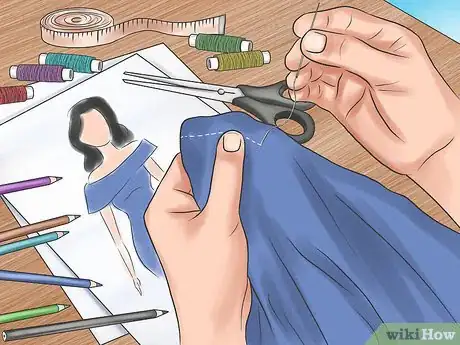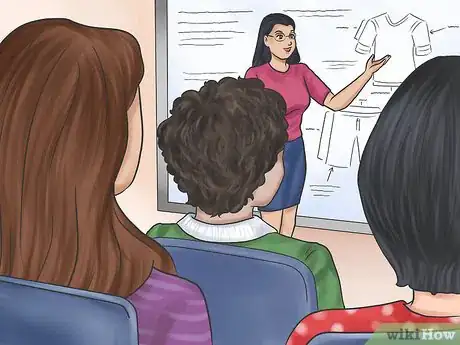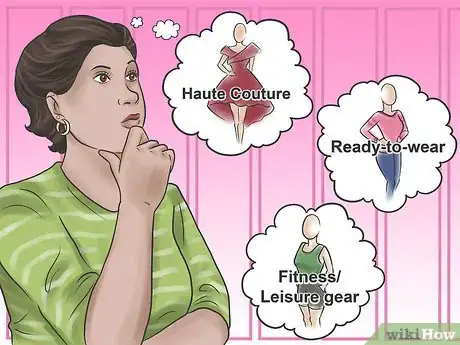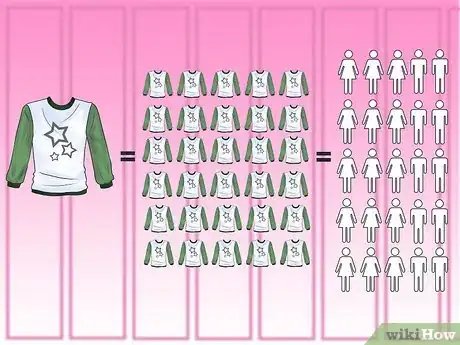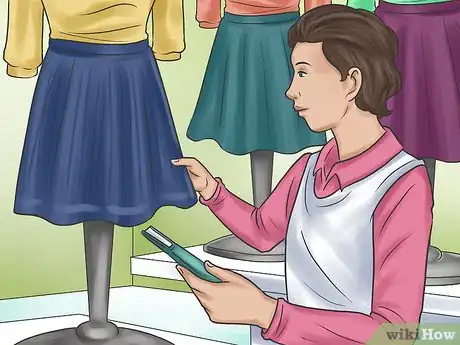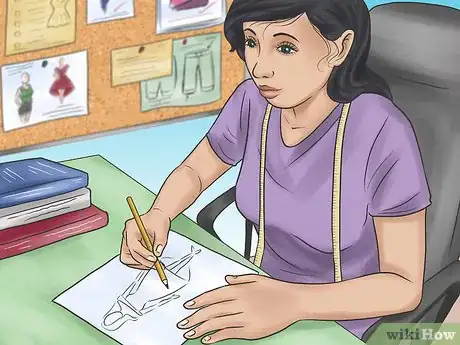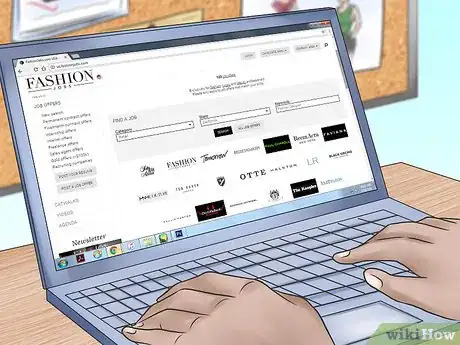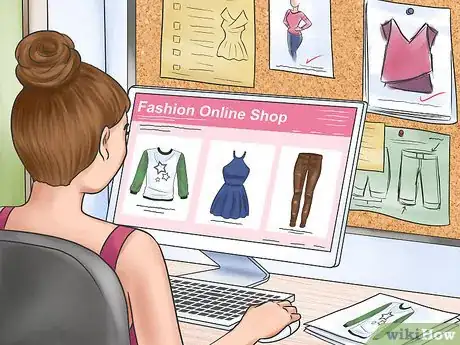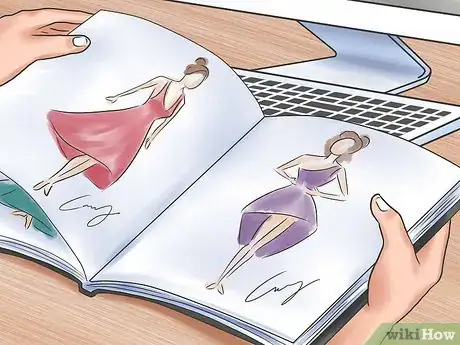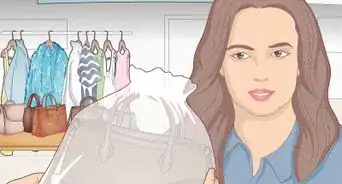This article was co-authored by Chloée Ohayon-Crosby. Chloée Ohayon-Crosby is a Costume Designer and Wardrobe Specialist in Los Angeles, California. With over eight years of experience in fashion consulting, Chloée specializes in personal, film, theater, and commercial styling as well as image consulting and costume design. Chloée has worked as an assistant designer for the distinguished fashion house Chloée and as a freelance stylist with Glamour Italia. Chloée studied Fine/Studio Arts at the Ecole Nationale Supérieure des Beaux-Arts and Fashion Design and Merchandising at the world renowned ESMOD École Supérieure des Arts in Paris, France.
There are 8 references cited in this article, which can be found at the bottom of the page.
wikiHow marks an article as reader-approved once it receives enough positive feedback. This article received 92 testimonials and 96% of readers who voted found it helpful, earning it our reader-approved status.
This article has been viewed 2,976,040 times.
There is no formal education or certification required to become a successful fashion designer, but that doesn't make the feat any easier. To become a fashion designer, you will need to have a combination of drawing, sewing, and design skills, a knowledge of the fashion industry, and unparalleled perseverance. You'll also need to create a strong fashion portfolio and strengthen your knowledge of business and finance in general.
Things You Should Know
- Develop skills in drawing, sewing, and design. If possible, pursue a degree in fashion design, or apply for a fashion internship or apprenticeship.
- Narrow your interest to a specific design field and practice your craft as much as possible. Create your own stylistic vision and expand on it.
- Learn about the business and marketing aspects of the fashion industry to give yourself a competitive edge.
Steps
Honing Your Fashion Design Skills
-
1Develop your skills. Successful fashion designers have a wide array of skills, including drawing, an eye for color and texture, an ability to visualize concepts in three dimensions, and the mechanical skills involved in sewing and cutting all types of fabrics.[1]
- Get excellent sewing tuition if you haven't already learned this skill well. Being able to sew difficult fabric under challenging situations will stand you in excellent stead throughout your career but you need to work at it - it's a skill that doesn't come easily to many people.
- Understand how fabrics move, drape, breathe, react when worn, etc. Your in-depth knowledge of fabric is absolutely essential to using it properly when designing. Also know where to source materials from.
- Learn from existing designers, not just who they are, but their backgrounds, their signature style, the learning that they undertook, where they studied. Knowing this will help you to be a better designer yourself, as you can borrow and build on their ideas.[2]
- Learn how to create storyboards and product ranges. Be good at researching trends and finding inspiration from social media, comparative shopping and trade shows.
- Start developing these skills at a young age. Be prepared to devote hours of time to perfecting your craft. A little bit everyday will make you gain a deep understanding of fashion on the long run if you are planning a career. Trying to do all at once might get you discouraged.
-
2Learn more. If you can, it makes good sense to get a diploma or degree in fashion design or a related program. You'll learn a great deal, make excellent early contacts and have ample opportunity to show off your skills in a less judgmental environment (although still be prepared to be critiqued!) Do one (or both) of the following:
- Get a degree in fashion design. Most programs are three or four years long. FIDM and Parsons are two of the most popular design schools in the United States. You will study drawing, color and composition, pattern-making, and draping.[3] In addition to learning practical skills like these, you will also be working with industry professionals who may serve as important contacts in the future and who can give you first-hand advice and feedback on your work.
- Apply for an internship or apprenticeship. If school is not for you, or if you simply feel that real-world experience will be of more benefit to you, then find a fashion internship. You will need to have an impressive portfolio to apply and be willing to start at the bottom; interns are often given menial tasks like getting coffee. Again, the connections you make through your internship or apprenticeship will be vital as you pursue your career in fashion, and working with industry professionals will give you an opportunity to pick up important skills first-hand.
Working Out Which Fashion is Your Passion
-
1Decide which designing field is your principal interest. You may need to start at the bottom but you do need to have some goals in mind as to the type of designing you want to undertake lifelong. Are you interested most in haute couture, ready-to-wear, fitness/leisure gear, the mass market or niches such as eco wear? Each has advantages and disadvantages that you'll need to explore before reaching your final decision on which pathway to pursue. Within these major fields, you'll also need to decide on a few sub-set areas for your fashion design. You might wish to straddle a few but, to begin with, don't over-extend yourself as it's better to perfect your designing within one area and then experiment when you've already got a good foothold in the industry. For example:[4]
- Women's daywear, women's evening wear
- Men's daywear, men's evening wear
- Boys' wear and/or girls' wear; teenage wear
- Sportswear/fitness/leisure wear
- Knitwear
- Outdoor, adventure, outerwear
- Bridal wear
- Accessories
- casual
- Costume design for theaters, movies, the advertising industry and retailers.
-
2Downsize your ego. Think about real needs prior to think about fame. Looking cool is fine, but it won't sell garments by itself. If you are planning to become a fashion designer, you will not only make apparel for yourself or for famous people. You can't be making a living out of that: they're not even 1% of the population. Even though you see big names in magazines: it's advertisement, not the reality. It doesn't work that way. Designers are especially needed for people with real, imperfect bodies that still want to look their best. Having a snob attitude will blind you from making money. Reality is: you don't design for yourself, you design for others.
-
3Ask your customers what they need. Be realistic: if you happen to live in a very warm country, you will have a tough time selling ski jackets. Look around you. What do real people need and want. For example, if you plan on designing a complete collection, you will need more tops that bottoms because most people have more tops than bottoms in their wardrobe in general. Tops are great to change your looks while a plain nice fitting pant will match most of your tops. Keep it simple and realistic. Extravagant sketches are nice on paper, but great tops and jeans will sell out in more interesting numbers than evening dresses.[5]
-
4Make concessions. Mass market may not sound as glamour as evening or luxury wear, but it will get you a long way and pay your groceries. If you have to create a style that will be produced more than a hundred times, you need to make it right from the start. It will improve your designing skills as you will have to understand perfectly the garment you are about to sell. Bad styles will get you returns and cost quite a bunch of money to your boss.[6]
-
5Get inspiration from your competitors. Observe and note the fabric they are using; the zipper size they use (for their garments to be strong enough for its usage); fabric quality for its properties such as impermeability, comfort, breathability or care; colours that sells in your country. Starting from your competitors qualities is not copying: it's observation. With taking the best of every pieces and analyzing it, you will understand what makes a "favorite" piece of clothing. They are usually best sellers. Your customers (whether they are buyers for stores or regular people) want something that looks good on them in the first place. Extravagant pieces are worn only a few days a year, they're great, but they may not bring you a salary to live with.
-
6Plan some key pieces. What is your absolute strength in designing? Perhaps you're a whizz at accessories or a genius with yoga pants. Your passion and skill are an important first part of the equation. Of course, the second part is matching this to what the market wants, which in fashion, is part convincing the market and part noticing what the market is demanding.
Setting Yourself Up for Success
-
1Get educated about the business side of fashion. Being a successful fashion designer not only requires talent and creativity, it also requires a sound knowledge of the business and marketing aspects of the fashion world. Keep yourself updated on the happenings in the fashion industry by regularly reading trade journals like Women's Wear Daily and Daily News Record.
- Many fashion design programs include courses in marketing. Some programs/majors highlight marketing more than others, so be sure to do ample research on the coursework involved in the program you choose. If you've already undertaken a course but missed the marketing/financial side of things, consider doing short courses in these aspects of business.
- Learn beyond design. There is an entire supply chain involved in the fashion industry and you need to understand what each person's job is, so that you can see things from their perspective too, in order to make compromises, meet demands and understand where things get held up. Research what others do, such as buyers, merchandisers, pattern cutters, garment and fabric technologists, quality controllers, graders, sample machinists, sales people, PR and marketing people, fashion journalists, retailers, event organizers, fashion stylists and so forth.
- Know your customer. This skill is basic and essential and it's one a fashion designer must never lose sight of. Know how much your customers spend, what their lifestyles are, where they like to shop, how they like to shop and what they like and dislike. Know what are absolute needs and what are the things that only get bought when disposable incomes are less tight. If you have done marketing, you should have a solid understanding of how to work out customers' needs.
- Know your competitors. Always keep an eye on what other fashion designers in your area of interest are doing. At a minimum, keep up. Better still, surpass them while still meeting your customers' needs.
- Trade fairs are an excellent place to develop deeper understanding of how the fashion industry works and what will work for you in terms of meeting customer needs and staying competitive.
-
2Look for fashion design jobs. There are various ways to find work in the fashion industry as a designer and it depends on the type of designing you're interested in. In some cases, being versatile will help you a great deal, just so that you get the experience and then jump across to your real passion later. And in most cases, you'll need to be persistent and apply to many different places to get your foot in the door. For starters, some places to apply to include:
- Existing fashion houses and designers - look for internships, entry-level paid positions, assistants to designers, etc.
- Costume positions with movie studios, theaters, costume stores, etc.
- Online advertisements through various online job agencies
- Word of mouth––use your college or fashion industry contacts to get you through the door. In an industry that values what people who already are well positioned have to say, this is a good way to get started.
-
3If running your own design business, be prepared to be financially astute. You may be exceptionally creative but be absolutely certain that if you run your own fashion label, you need to be business savvy. You do need to understand those numbers and the invoices that keep piling up on your table. If you really hate this stuff, there are good options, such as asking your accountant to take care of all things financial but it still pays to keep on top of the whole thing yourself. And if you really, really hate this side of it, look for work as a fashion designer with a fashion house instead of running your own label.[7]
- What type of trader will you be? There are many possibilities, including sole trader, partnership, incorporated company, etc. Each has distinct advantages and disadvantages that you should discuss with your legal and financial advisers before proceeding. Be sure that you are covered for liability in all circumstances, especially if you're in a particularly litigious culture.
-
4Be realistic. You may need to be willing to move to match your market but that depends on how you work and sell. Being realistic means recognizing that it's pointless trying to sell a lot of haute couture to people who only want career clothing in a semi-rural town while it's no good trying to sell bikini to the Inuit. You'll need to focus on where your market is most likely to be and either work out whether it's best for you to live and work in that same area or how to get the distribution from your current area to the place where it's most likely to sell.
- Take into consideration the influences around you. As a creative person, part of your creative process is being around like people and sparking off their ideas and suggestions too. It's a lot harder to do this alone or working alongside people who aren't into your fashion approaches.
- Remember too that seasonality impacts fashion designing and may have an impact on the type of clothing you're producing and where you wish to sell it.
- Consider the power of online selling. Provided you use good quality three dimensional images that can be zoomed and turned, selling your fashion online to anywhere in the world is another realistic possibility nowadays. This allows you greater flexibility in where you'll live and design and can reduce the daily commute to zero. This may be ideal if you plan on staying a small fashion label. Even then however, you should still make allowances for traveling to major fashion shows.
- Living in a city with a thriving fashion industry makes good sense for many designers. According to the Global Language Monitor (GLM), the following cities were the top fashion capitals of the world in 2012, in descending order:[8]
- London, England
- New York, US
- Barcelona, Spain
- Paris, France
- Mexico City
- Madrid, Spain
- Rome, Italy
- Sao Palo, Brazil
- Milan, Italy
- Los Angeles, US
- Berlin, Germany.
- Mumbai, India
Community Q&A
Did you know you can get expert answers for this article?
Unlock expert answers by supporting wikiHow
-
QuestionHow can I start fashion designing?
 Chloée Ohayon-CrosbyChloée Ohayon-Crosby is a Costume Designer and Wardrobe Specialist in Los Angeles, California. With over eight years of experience in fashion consulting, Chloée specializes in personal, film, theater, and commercial styling as well as image consulting and costume design. Chloée has worked as an assistant designer for the distinguished fashion house Chloée and as a freelance stylist with Glamour Italia. Chloée studied Fine/Studio Arts at the Ecole Nationale Supérieure des Beaux-Arts and Fashion Design and Merchandising at the world renowned ESMOD École Supérieure des Arts in Paris, France.
Chloée Ohayon-CrosbyChloée Ohayon-Crosby is a Costume Designer and Wardrobe Specialist in Los Angeles, California. With over eight years of experience in fashion consulting, Chloée specializes in personal, film, theater, and commercial styling as well as image consulting and costume design. Chloée has worked as an assistant designer for the distinguished fashion house Chloée and as a freelance stylist with Glamour Italia. Chloée studied Fine/Studio Arts at the Ecole Nationale Supérieure des Beaux-Arts and Fashion Design and Merchandising at the world renowned ESMOD École Supérieure des Arts in Paris, France.
Costume Designer & Wardrobe Specialist
-
QuestionHow can I know what to design?
 Community AnswerGet inspired by the world and what you see. That's the key to picking out what to draw and design.
Community AnswerGet inspired by the world and what you see. That's the key to picking out what to draw and design. -
QuestionHow do I start as a 14 year old?
 Community AnswerDesign doesn't have an age, all that you need to do is show your passion and develop your skills. Look online for fashion internships or maybe start a YouTube channel. You don't have to actually work for someone to show who you are. Maybe invite your friends over and have a fashion show.
Community AnswerDesign doesn't have an age, all that you need to do is show your passion and develop your skills. Look online for fashion internships or maybe start a YouTube channel. You don't have to actually work for someone to show who you are. Maybe invite your friends over and have a fashion show.
Warnings
- The fashion industry is extremely competitive; only pursue a career in fashion if it you are 100 percent devoted to the field. It also helps to grow a thick hide very early on and to learn to be discerning about criticism––most criticism is sour grapes and if you believe in yourself, you'll know when the criticism is spot on or just plain nasty.⧼thumbs_response⧽
- Working as a designer can be a physically strenuous career. You will need to be willing to work unexpected long hours to meet deadlines.⧼thumbs_response⧽
- Designing for catwalks and high end fashion will bring you into direct contact with the challenging aspects of the industry, including using underweight models for fitting (thereby potentially making you complicit in encouraging unhealthy portrayals of women and men), cattiness from fellow designers and fashion industry elites and very difficult demands including tight deadlines. If you're not already an assertive person, it would be wise to spend time improving your skills in communicating and standing up for your principles.⧼thumbs_response⧽
References
- ↑ https://www2.jobsandskills.wa.gov.au/career-exploration/Occupations/Pages/fashion-designer.aspx
- ↑ Chloée Ohayon-Crosby. Fashion Stylist. Expert Interview. 24 July 2020.
- ↑ http://www.fashion.net/howto/fashiondesigner/
- ↑ https://www.jdinstitute.com/types-of-fashion-designing-courses-in-india/
- ↑ https://www.infoentrepreneurs.org/en/guides/know-your-customers--needs/
- ↑ https://hbswk.hbs.edu/item/four-strategies-for-making-concessions
- ↑ http://money.com/money/4722984/5-things-to-know-reach-financial-goals/
- ↑ http://www.theatlanticcities.com/jobs-and-economy/2012/09/worlds-leading-cities-fashion/3182/
About This Article
If you want to become a fashion designer, enroll in a school for fashion design, where you can study fabrics, sewing techniques, and the history of fashion. If school isn’t for you, apply for an apprenticeship or internship working for a fashion designer. As you’re completing your training, design and create clothing for customers to build your portfolio. Once you’ve completed school or your internship, you can either apply for jobs with different clothing manufacturers or you can start your own clothing label. For tips on assembling your fashion portfolio, keep reading!
